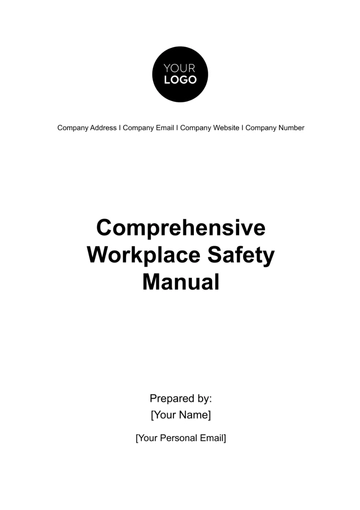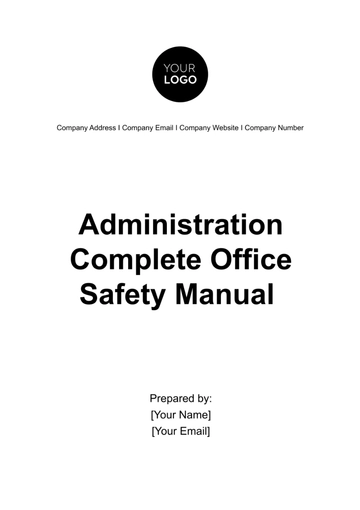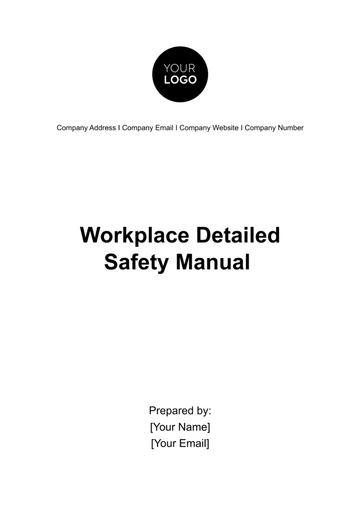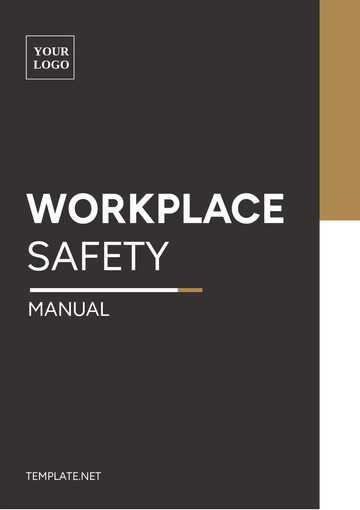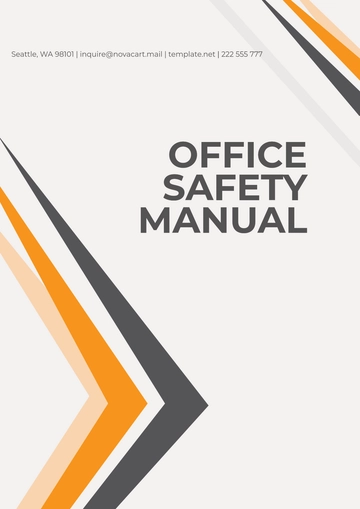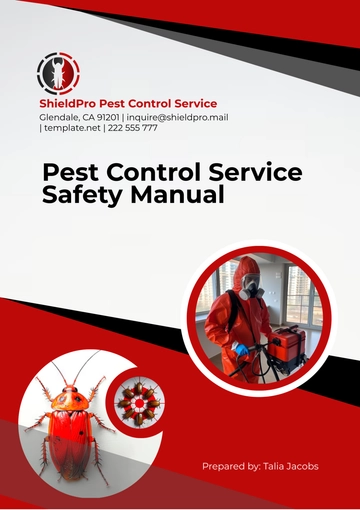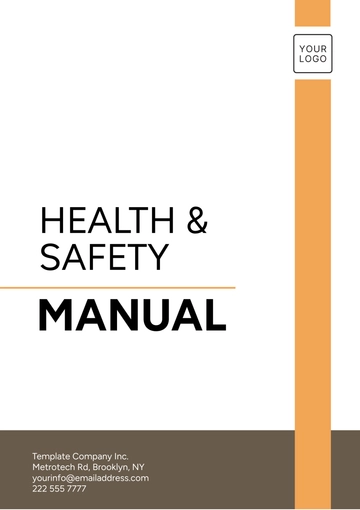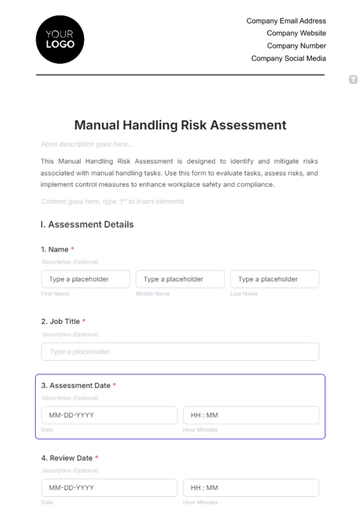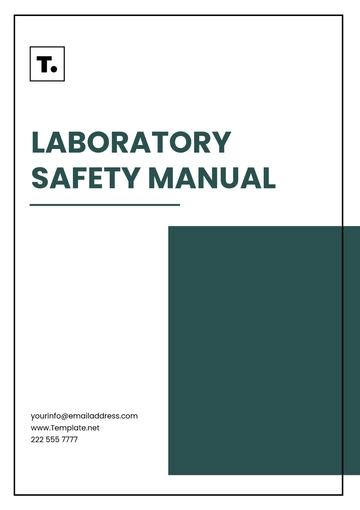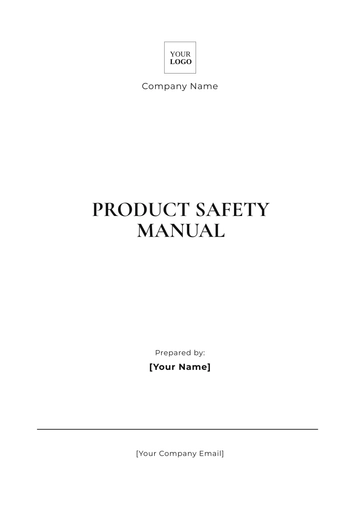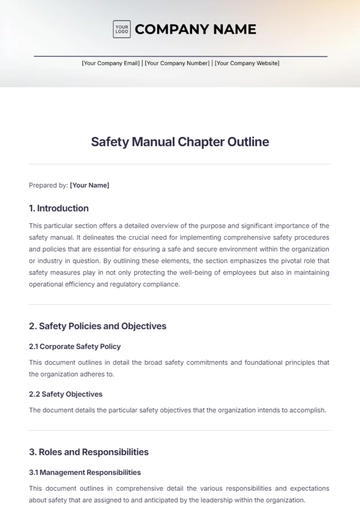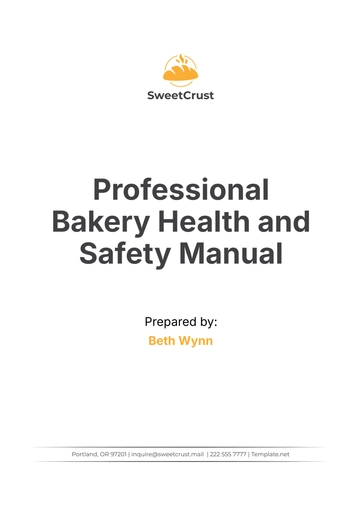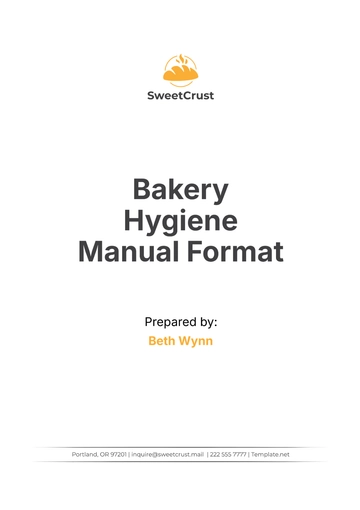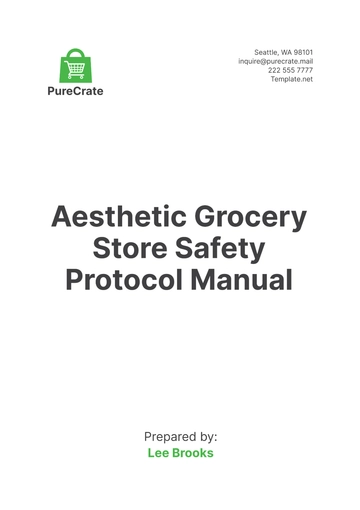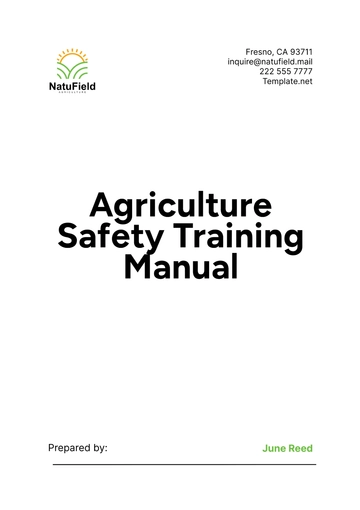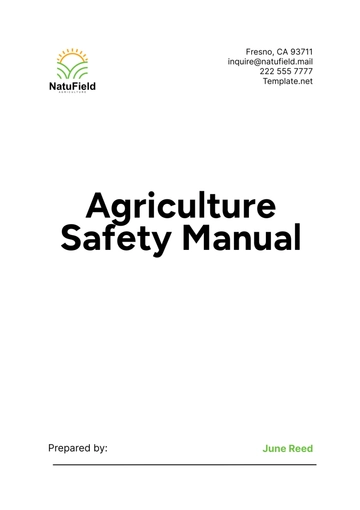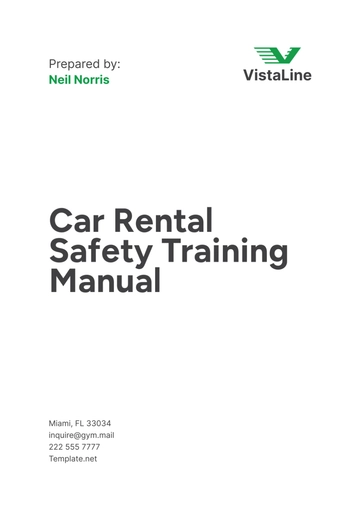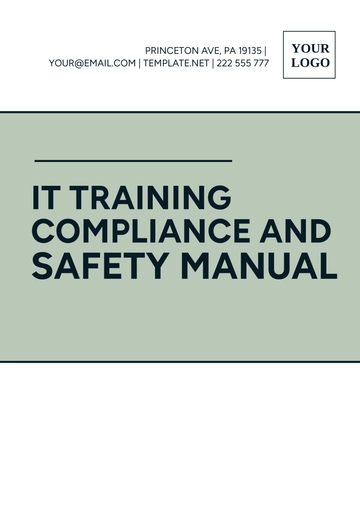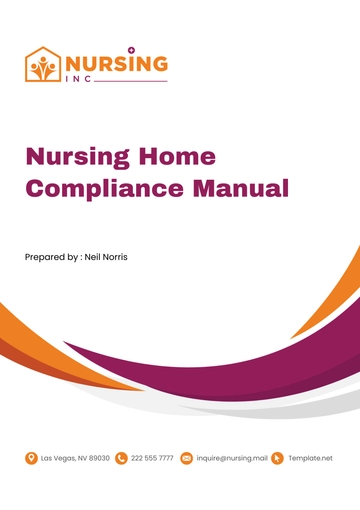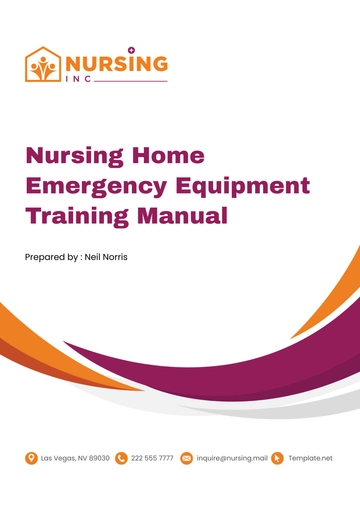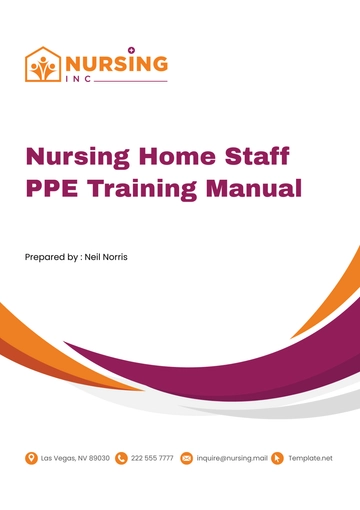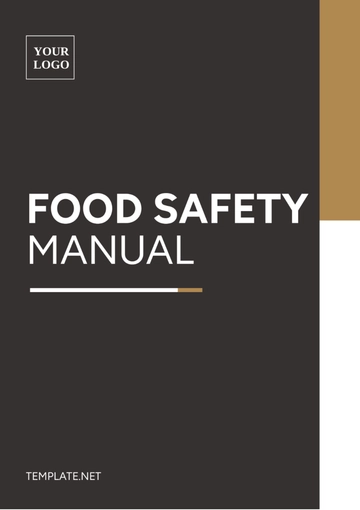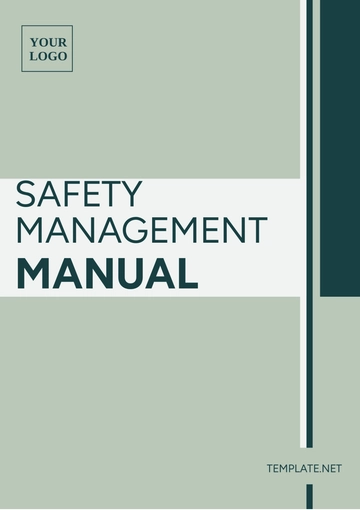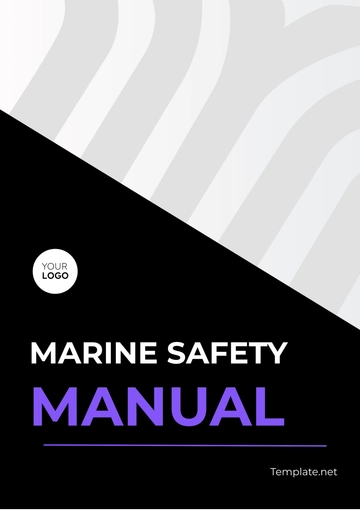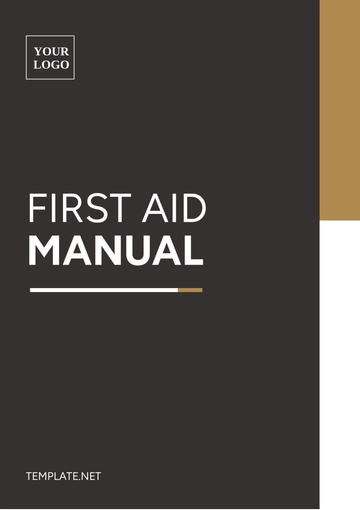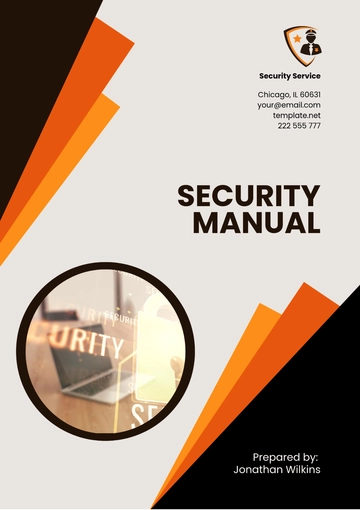Free Professional Bakery Health and Safety Manual
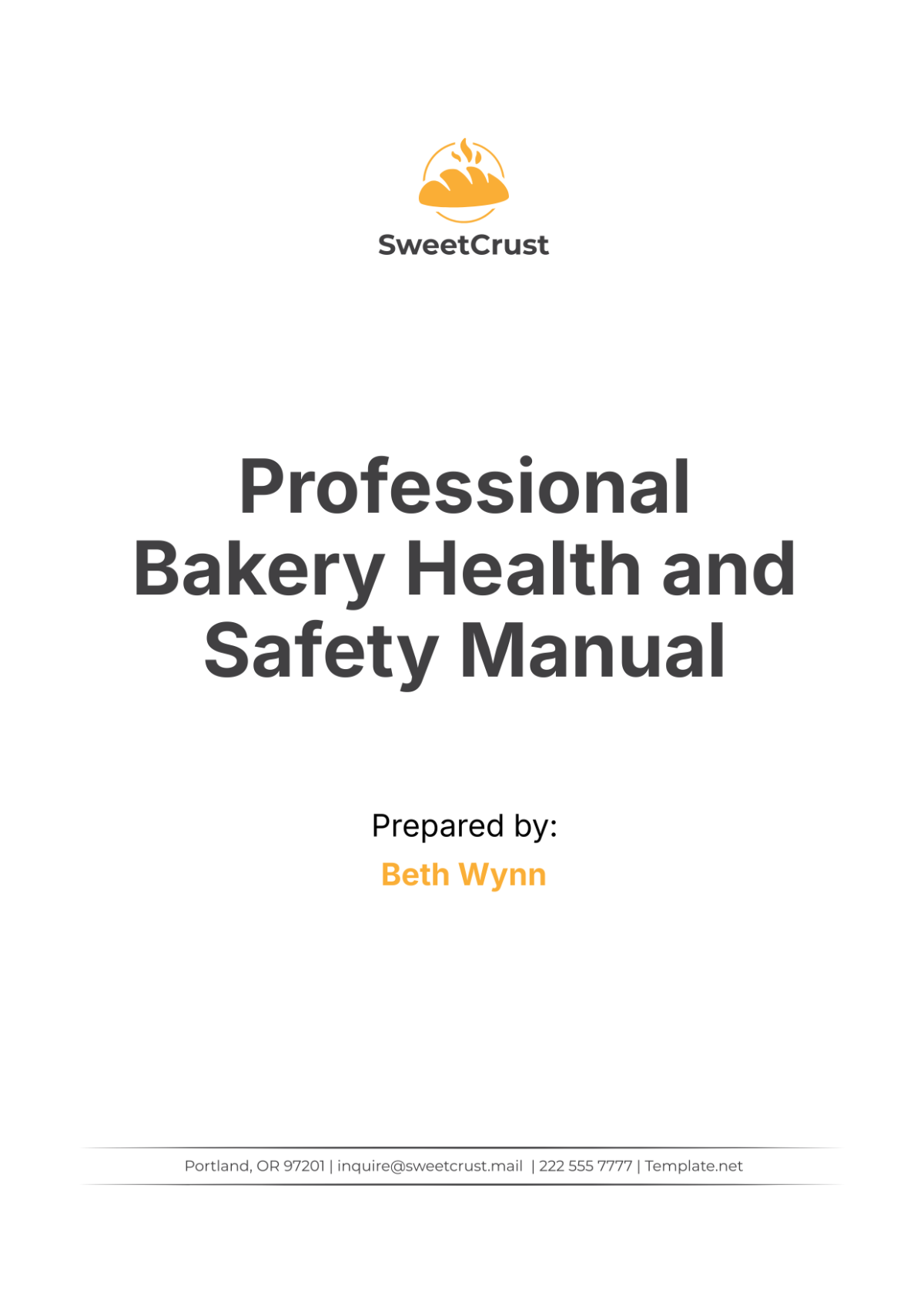
I. Introduction
A. Purpose of the Health and Safety Manual
The primary purpose of this Health and Safety Manual is to provide a comprehensive framework for ensuring the health and safety of all employees, contractors, and visitors at [Your Company Name]. This manual is designed to outline the key policies, procedures, and practices necessary to create a safe working environment in our bakery operations. By adhering to the guidelines set forth in this manual, we aim to minimize risks and ensure compliance with health and safety regulations. This manual serves as a reference for both new and existing employees, providing them with the knowledge and tools needed to work safely and efficiently.
B. Scope
This manual encompasses all aspects of health and safety within [Your Company Name], including general workplace safety, equipment and machinery safety, food safety, emergency procedures, and training programs. It applies to every individual within the organization, including full-time and part-time employees, contractors, and temporary workers. Additionally, it covers all areas of the bakery, from production and storage to administrative offices and break rooms. The scope of this manual ensures that all operations within the bakery are conducted in a manner that prioritizes the health and safety of everyone involved.
C. Policy Statement
At [Your Company Name], we are committed to maintaining the highest standards of health and safety in the workplace. We recognize that a safe working environment is essential for the well-being of our employees and the overall success of our business. Our policy is to prevent accidents, injuries, and illnesses through proactive measures and continuous improvement. We are dedicated to complying with all relevant health and safety legislation and industry standards. Our commitment extends to providing necessary resources, training, and support to all employees, ensuring that they can perform their duties safely and effectively.
II. Health and Safety Responsibilities
A. Management Responsibilities
Implementation and Enforcement: Management is responsible for implementing and enforcing the health and safety policies and procedures outlined in this manual. This involves ensuring that all workplace practices adhere to established safety standards and that any necessary updates or changes are made promptly.
Training and Resources: Management must provide employees with adequate training and resources to carry out their tasks safely. This includes organizing regular safety training sessions, supplying personal protective equipment (PPE), and ensuring access to safety information and resources.
Risk Assessments and Inspections: Conducting regular risk assessments and inspections is a key responsibility of management. These assessments help identify potential hazards and evaluate their risks, enabling the development of effective control measures to mitigate those risks.
Promoting Safety Culture: Management should foster a culture of safety within the organization by leading by example, encouraging open communication about health and safety concerns, and recognizing and rewarding safe work practices.
B. Employee Responsibilities
Adherence to Policies: Employees are required to adhere to the health and safety policies and procedures established by [Your Company Name]. This includes following all safety instructions, using PPE correctly, and maintaining a clean and organized work area.
Reporting Hazards: Employees should report any hazards, unsafe conditions, or incidents to their supervisor immediately. Prompt reporting helps to address potential risks before they result in accidents or injuries.
Participating in Training: Participation in health and safety training programs is a fundamental responsibility of employees. Training ensures that employees are aware of safety procedures and can apply them effectively in their daily tasks.
Personal Responsibility: Employees must take personal responsibility for their own health and safety, as well as that of their colleagues. This includes practicing good hygiene, using equipment properly, and contributing to a safe and healthy work environment.
C. Health and Safety Committee
Composition and Role: The Health and Safety Committee at [Your Company Name] consists of representatives from both management and employees. The committee's role is to review and update health and safety policies, conduct regular inspections, and address any concerns raised by employees.
Meetings and Communication: The committee meets regularly to discuss health and safety issues, review incident reports, and develop strategies for improvement. Effective communication with employees is a key component of the committee's role, ensuring that all staff are informed about health and safety matters.
Review and Recommendations: The committee is responsible for reviewing current health and safety practices and making recommendations for improvements. This may involve updating procedures, implementing new safety measures, or enhancing training programs.
III. Risk Management
A. Hazard Identification
Proactive Identification: Hazard identification involves proactively identifying potential hazards that could pose a risk to employees. This includes physical hazards, such as sharp objects and hot surfaces, as well as chemical, biological, and ergonomic hazards.
Employee Involvement: All employees are encouraged to participate in hazard identification by reporting any unsafe conditions or practices they observe. This collaborative approach helps to ensure that all potential hazards are identified and addressed.
Common Hazards: In a bakery setting, common hazards may include exposure to hot ovens and surfaces, sharp kitchen tools, heavy lifting, and contact with cleaning chemicals. Identifying these hazards is crucial for developing effective control measures.
B. Risk Assessment
Assessment Process: Risk assessment involves evaluating the likelihood and severity of harm associated with identified hazards. This process helps to prioritize risks and determine the appropriate control measures to mitigate them.
Risk Evaluation: During the risk assessment, each hazard is analyzed to assess its potential impact on employees and the likelihood of occurrence. This evaluation helps to identify high-risk areas that require immediate attention and action.
Regular Reviews: Risk assessments should be reviewed regularly and updated as needed. Changes in work processes, equipment, or regulations may necessitate updates to the risk assessment to ensure ongoing safety.
C. Risk Control
Control Measures: Risk control involves implementing measures to reduce or eliminate identified risks. These measures may include engineering controls, administrative controls, and the use of personal protective equipment (PPE).
Engineering Controls: Engineering controls involve modifying equipment or processes to reduce hazards. For example, installing safety guards on machinery or improving ventilation systems can help mitigate risks.
Administrative Controls: Administrative controls include implementing policies and procedures that promote safe work practices. This may involve establishing work procedures, scheduling regular breaks, and providing training on safe work practices.
PPE: Personal protective equipment (PPE) is used as a last resort when other control measures are not sufficient. PPE may include gloves, aprons, safety glasses, and hearing protection, depending on the nature of the hazard.
IV. Workplace Safety
A. General Workplace Safety
Maintaining Cleanliness: Maintaining a clean and organized work environment is essential for preventing accidents and injuries. All work areas should be kept free of clutter, and spills should be cleaned up immediately to prevent slips and falls.
Proper Lighting and Ventilation: Adequate lighting and ventilation are important for creating a safe and comfortable working environment. Ensure that work areas are well-lit and that proper ventilation is provided to prevent the buildup of fumes or odors.
Safe Practices: Employees should follow safe work practices, including proper lifting techniques and ergonomic practices. Adhering to these practices helps to prevent musculoskeletal injuries and other common workplace issues.
B. Equipment and Machinery Safety
Maintenance and Inspection: Equipment and machinery used in the bakery must be properly maintained and regularly inspected to ensure safe operation. Regular maintenance helps to prevent breakdowns and reduces the risk of accidents caused by faulty equipment.
Safe Use Training: Employees should receive training on the safe use of equipment and machinery. This training should cover operating procedures, safety features, and emergency shutdown procedures.
Safety Guards: Safety guards and devices should be in place and functioning properly to protect employees from moving parts and other hazards. Regular checks should be conducted to ensure that these safety features are in good working condition.
C. Electrical Safety
Inspection and Maintenance: Electrical safety involves ensuring that all electrical equipment is inspected and maintained regularly by qualified personnel. This helps to prevent electrical shocks, burns, and fires.
Recognizing Hazards: Employees should be trained to recognize electrical hazards, such as exposed wiring or overloaded circuits, and to report them immediately. Addressing these hazards promptly helps to prevent accidents.
Proper Use: Employees should follow safe practices when using electrical equipment, including avoiding the use of damaged cords or equipment. Electrical equipment should be used in accordance with the manufacturer’s instructions.
D. Fire Safety
Preventive Measures: Preventive measures for fire safety include regularly checking and maintaining fire detection and suppression systems, such as smoke alarms, fire extinguishers, and sprinklers. Ensure that these systems are serviced according to manufacturer recommendations and local regulations.
Fire Drills: Conduct regular fire drills to practice evacuation procedures and ensure that all employees are familiar with emergency exits and assembly points. Fire drills help to ensure a swift and orderly evacuation in case of an actual fire.
Fire Safety Training: Provide training for employees on fire safety procedures, including how to use fire extinguishers, how to evacuate the building safely, and how to respond in case of a fire emergency. Training should be provided upon hiring and refreshed periodically.
E. Chemical Safety
Proper Storage: Chemicals used in the bakery should be stored properly in designated areas that are well-ventilated and secure. Labels and safety data sheets (SDS) should be readily accessible, and chemicals should be stored in their original containers to prevent accidental mixing.
Handling Procedures: Employees should be trained on the safe handling and use of chemicals, including the use of appropriate personal protective equipment (PPE) and safe disposal procedures. Ensure that employees are aware of the potential hazards associated with each chemical they handle.
Emergency Procedures: In case of a chemical spill or exposure, employees should follow established emergency procedures, which may include evacuating the area, using spill kits, and seeking medical attention if necessary. Emergency response plans should be clearly communicated and practiced regularly.
F. Personal Protective Equipment (PPE)
Selection and Use: Personal protective equipment (PPE) should be selected based on the specific hazards present in the workplace. Common PPE in a bakery may include gloves, aprons, safety glasses, and ear protection. Employees must be trained on how to use and maintain PPE properly.
Inspection and Maintenance: PPE should be inspected regularly for damage or wear and replaced as needed. Maintenance procedures should be followed to ensure that PPE remains effective and in good condition.
Compliance: Ensure that all employees comply with PPE requirements and wear the appropriate equipment as specified in health and safety policies. Regularly review and update PPE policies to address changes in workplace conditions or regulations.
V. Food Safety and Hygiene
A. Personal Hygiene
Hand Washing: Employees must practice proper hand hygiene by washing their hands thoroughly with soap and water before handling food, after using the restroom, and after any activity that may contaminate hands. Hand washing stations should be readily available and stocked with soap and disposable towels.
Clean Clothing: Employees should wear clean clothing and maintain good personal hygiene to prevent contamination of food products. Aprons, hairnets, and other protective clothing should be clean and in good condition.
Health Monitoring: Employees should be monitored for symptoms of illness that could affect food safety, such as gastrointestinal issues or respiratory infections. Employees showing symptoms should be excluded from food handling until they are well.
B. Food Handling and Storage
Temperature Control: Proper temperature control is crucial for food safety. Ensure that refrigerators, freezers, and hot holding equipment are maintained at the correct temperatures to prevent the growth of harmful bacteria. Regular temperature checks should be conducted and recorded.
Cross-Contamination Prevention: Prevent cross-contamination by using separate utensils, cutting boards, and storage containers for raw and cooked foods. Ensure that surfaces and equipment are cleaned and sanitized regularly to eliminate potential sources of contamination.
Food Storage: Store food items properly in labeled, sealed containers to maintain freshness and prevent contamination. Follow the first-in, first-out (FIFO) method for inventory management to ensure that older products are used before newer ones.
C. Cleaning and Sanitation
Cleaning Protocols: Establish and follow detailed cleaning protocols for all areas of the bakery, including food preparation surfaces, equipment, floors, and restrooms. Cleaning schedules should be maintained and followed rigorously.
Sanitizing Procedures: Use appropriate sanitizing agents to disinfect surfaces and equipment after cleaning. Ensure that sanitizers are used according to manufacturer instructions and that contact times are adhered to for effective disinfection.
Regular Inspections: Conduct regular inspections to ensure that cleaning and sanitation practices are being followed correctly. Address any issues or deficiencies promptly to maintain a hygienic environment.
D. Pest Control
Preventive Measures: Implement preventive measures to minimize the risk of pest infestations, such as sealing entry points, maintaining cleanliness, and properly storing food items. Regularly inspect the premises for signs of pests.
Pest Control Services: Engage professional pest control services to conduct regular inspections and treatments as needed. Document pest control activities and follow up on any issues identified during inspections.
Employee Training: Train employees to recognize signs of pest activity and to report any concerns promptly. Provide guidance on how to handle pest-related issues and maintain a pest-free environment.
VI. Emergency Procedures
A. Emergency Contact Information
Contact List: Display emergency contact information prominently in common areas, such as near telephones, break rooms, and entry points. This list should include emergency services (fire, police, medical), key internal contacts, and any other relevant numbers.
Access and Updates: Ensure that contact information is easily accessible and updated regularly to reflect any changes in phone numbers or emergency contacts. Communicate any updates to employees to ensure they are aware of the current contact information.
Employee Awareness: All employees should be familiar with emergency contact information and know how to use it in case of an emergency. Conduct regular training and drills to ensure that employees are prepared to act swiftly in an emergency situation.
B. First Aid
First Aid Kit: Maintain a fully stocked first aid kit in easily accessible locations throughout the bakery. The kit should include items such as bandages, antiseptic wipes, adhesive tape, and emergency contact numbers.
First Aid Training: Designate employees to receive first aid and CPR training to ensure that there are trained individuals available to provide immediate assistance in case of an injury or medical emergency. Training should be refreshed periodically.
Incident Documentation: Document all incidents requiring first aid treatment, including the nature of the injury, the treatment provided, and any follow-up actions. This documentation helps in tracking incidents and identifying any trends or recurring issues.
C. Fire Emergency Procedures
Evacuation Plan: Develop and clearly communicate a fire evacuation plan that includes designated exit routes, assembly points, and procedures for assisting individuals with disabilities. The plan should be prominently displayed and reviewed regularly.
Fire Drills: Conduct regular fire drills to practice evacuation procedures and ensure that all employees are familiar with the plan. Drills should be scheduled at least twice a year and should involve all employees.
Reporting Fires: In the event of a fire, employees should know how to activate the fire alarm system, notify emergency services, and evacuate the building quickly and safely. Ensure that procedures for reporting and responding to fires are well understood by all employees.
D. Evacuation Procedures
Clear Routes: Ensure that all evacuation routes are clearly marked, free of obstructions, and easily accessible. Exit signs should be illuminated and visible at all times, and emergency lighting should be tested regularly.
Evacuation Training: Provide training to employees on evacuation procedures, including how to exit the building safely and where to gather at the assembly point. Training should include procedures for evacuating individuals with special needs or mobility issues.
Assembly Points: Designate assembly points outside the building where employees should gather after evacuating. Ensure that assembly points are located a safe distance from the building and are clearly marked.
VII. Health and Safety Training
A. Training Programs
Comprehensive Training: Develop and implement comprehensive health and safety training programs that cover all aspects of workplace safety, including hazard identification, safe work practices, and emergency procedures. Training should be tailored to the specific needs and risks of the bakery environment.
New Employee Training: Provide health and safety training to all new employees as part of their onboarding process. This training should cover the bakery's health and safety policies, emergency procedures, and specific job-related hazards.
Ongoing Training: Offer ongoing training and refresher courses to ensure that all employees remain up-to-date with current health and safety practices. This may include updates on new regulations, changes in procedures, or lessons learned from incident reports.
B. Training Records
Documentation: Maintain detailed records of all health and safety training activities, including the date of training, topics covered, and the names of employees who attended. This documentation helps track compliance and identify any training needs.
Review and Update: Regularly review training records to ensure that all employees have completed required training and that their certifications are up-to-date. Address any gaps or deficiencies in training as needed.
Accessibility: Ensure that training records are securely stored and easily accessible for review by health and safety inspectors, auditors, or other relevant parties. Maintain records for a specified period as required by regulations.
C. Continuous Improvement
Feedback and Evaluation: Continuously evaluate the effectiveness of health and safety training programs by gathering feedback from employees and analyzing incident reports. Use this feedback to identify areas for improvement and to enhance training content.
Program Updates: Update training programs regularly to reflect changes in legislation, industry standards, and bakery operations. Ensure that training materials and procedures are current and relevant to the needs of the organization.
Evaluation Metrics: Establish metrics to evaluate the success of training programs, such as incident rates, employee knowledge assessments, and feedback surveys. Use these metrics to drive improvements and ensure that training programs are effective.
VIII. Health and Safety Inspections and Audits
A. Regular Inspections
Inspection Schedule: Develop and implement a schedule for regular health and safety inspections of the bakery. Inspections should cover all areas of the workplace, including production areas, storage rooms, and common areas.
Inspection Checklists: Use detailed inspection checklists to ensure that all relevant health and safety aspects are evaluated. Checklists should be customized to address specific hazards and requirements of the bakery environment.
Follow-Up Actions: Document inspection findings and take prompt corrective actions to address any identified issues. Follow-up inspections may be necessary to ensure that corrective measures have been effectively implemented.
B. Audit Procedures
Internal Audits: Conduct regular internal audits to evaluate the effectiveness of health and safety policies and procedures. Audits should assess compliance with regulations, identify areas for improvement, and verify that corrective actions have been taken.
External Audits: Engage external auditors to provide an independent assessment of health and safety practices. External audits offer a fresh perspective and help identify any areas that may require additional attention or improvement.
Audit Reports: Prepare detailed audit reports that document findings, recommendations, and actions taken. Share these reports with management and employees to ensure transparency and accountability.
C. Reporting and Documentation
Documentation of Findings: Document all inspection and audit findings, including any non-compliance issues, hazards, and recommendations for improvement. Maintain detailed records to support the implementation of corrective actions and track progress.
Reporting Procedures: Establish procedures for reporting inspection and audit findings to relevant stakeholders, including management and the health and safety committee. Ensure that reports are reviewed and acted upon in a timely manner.
Continuous Improvement: Use inspection and audit findings to drive continuous improvement in health and safety practices. Regularly review and update policies and procedures based on audit results and feedback.
IX. Incident Reporting and Investigation
A. Incident Reporting Procedure
Reporting Process: Establish a clear procedure for reporting workplace incidents, including injuries, near misses, and property damage. Employees should be aware of how to report incidents and who to contact in case of an emergency.
Reporting Forms: Provide incident reporting forms that capture essential details, such as the nature of the incident, the individuals involved, and any immediate actions taken. Ensure that forms are readily accessible and easy to complete.
Timeliness: Encourage prompt reporting of incidents to ensure that they are investigated and addressed in a timely manner. Delayed reporting can hinder the investigation process and affect the implementation of corrective actions.
B. Investigation Process
Investigation Team: Assemble an investigation team consisting of individuals with relevant expertise and knowledge of the incident. The team should include representatives from management, the health and safety committee, and any other relevant departments.
Root Cause Analysis: Conduct a thorough investigation to identify the root causes of the incident. This may involve analyzing contributing factors, reviewing procedures, and interviewing witnesses. The goal is to determine what went wrong and how similar incidents can be prevented in the future.
Corrective Actions: Develop and implement corrective actions based on the investigation findings. Corrective actions may include changes to procedures, additional training, or equipment modifications. Ensure that corrective actions are tracked and verified for effectiveness.
C. Corrective Actions
Action Plan: Create an action plan to address the findings of the incident investigation. The action plan should outline specific steps to be taken, responsible individuals, and timelines for implementation.
Follow-Up: Monitor the implementation of corrective actions to ensure that they are completed as planned. Follow-up inspections or reviews may be necessary to verify that the actions have effectively addressed the identified issues.
Communication: Communicate the results of the investigation and the corrective actions taken to all employees. Transparency helps to reinforce the importance of safety and ensures that everyone is aware of the measures in place to prevent future incidents.
X. Review and Continuous Improvement
A. Annual Review
Review Schedule: Conduct an annual review of the health and safety manual and associated policies to ensure they remain current and effective. This review should include an assessment of any changes in regulations, industry standards, or bakery operations.
Update Policies: Based on the annual review, update policies and procedures as needed to address any identified gaps or areas for improvement. Ensure that all changes are communicated to employees and incorporated into training programs.
Performance Evaluation: Evaluate the overall performance of the health and safety program, including incident rates, audit findings, and employee feedback. Use this evaluation to identify strengths and areas for improvement.
B. Continuous Improvement Plan
Improvement Initiatives: Develop a continuous improvement plan that outlines initiatives to enhance health and safety practices. This plan should be based on data collected from inspections, audits, and incident reports.
Employee Involvement: Encourage employee involvement in the continuous improvement process by soliciting feedback and suggestions. Employees often have valuable insights into potential improvements and can contribute to a safer work environment.
Monitoring Progress: Monitor the progress of improvement initiatives and assess their effectiveness. Adjust the plan as needed to address any emerging issues or changes in workplace conditions.
- 100% Customizable, free editor
- Access 1 Million+ Templates, photo’s & graphics
- Download or share as a template
- Click and replace photos, graphics, text, backgrounds
- Resize, crop, AI write & more
- Access advanced editor
Promote a safe work environment with the Professional Bakery Health and Safety Manual Template from Template.net. This customizable and editable tool offers a detailed format for health and safety guidelines. Use our Ai Editor Tool to draft manuals covering safety protocols, emergency procedures, and health regulations, ensuring a secure and compliant bakery operation.
